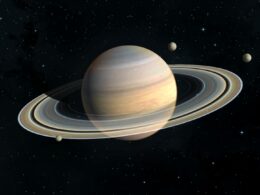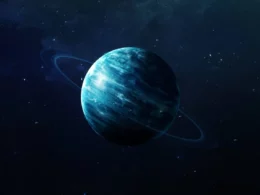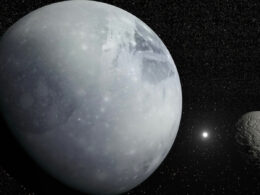Jupiter, the largest planet in our solar system, is known for its massive size and its iconic red spot. But have you ever wondered how long a day on Jupiter is? The answer may surprise you.
While a day on Earth lasts 24 hours, a day on Jupiter is much shorter, lasting only about 9 hours and 56 minutes. This is due to Jupiter’s rapid rotation on its axis, which is the imaginary line that runs through the planet’s center and connects its north and south poles. In fact, Jupiter rotates so quickly that its equator bulges out slightly, making it wider at the equator than it is from pole to pole.
Jupiter’s fast rotation also has other interesting effects. For example, it creates powerful jet streams in the planet’s atmosphere, which can reach speeds of up to 620 kilometers per hour (385 miles per hour). These jet streams can create massive storms, such as the Great Red Spot, which is a giant storm that has been raging on Jupiter for at least 350 years.

Characteristics of Jupiter’s Rotation
Jupiter is the largest planet in our solar system and rotates faster than any other planet. Its rotation is a significant aspect of its characteristics, and this section will explore the various aspects of Jupiter’s rotation.
Jupiter’s Rotational Speed and Length of a Day
Jupiter rotates on its axis once every 9 hours and 56 minutes, making it the fastest rotating planet in our solar system. This means that a day on Jupiter is only slightly less than 10 Earth hours long. However, it is essential to note that the length of a day on Jupiter varies depending on the observer’s location on the planet.
Comparative Analysis with Earth
In contrast, a day on Earth is 24 hours long, making Jupiter’s day significantly shorter than Earth’s day. This difference in the length of a day is due to the difference in the rotational speed of the two planets. Jupiter’s rotational speed is approximately 28 times faster than Earth’s rotational speed.
Impact of Jupiter’s Size and Mass
Jupiter’s size and mass significantly impact its rotational speed and length of a day. Being the largest planet in our solar system, Jupiter has a diameter of 139,822 kilometers, which is more than 11 times the diameter of Earth. Its massive size and mass cause it to rotate faster and have a shorter day than Earth.
Observations and Studies
Spacecraft and Astronomical Observations
Jupiter is the largest planet in our solar system and is classified as a gas giant. It has a very short day, spinning around rapidly, completing a full rotation in just about 10 hours. This unique characteristic of Jupiter’s rapid rotation sets it apart from all other planets in our solar system. This fact has been confirmed by several spacecraft and astronomical observations, including NASA’s Juno mission, which has been orbiting Jupiter since 2016.
Juno has been studying Jupiter’s atmosphere, magnetic field, and gravity field. It has revealed that Jupiter has a complex and dynamic atmosphere with many storms, including the Great Red Spot, a giant storm that has raged for hundreds of years. Juno has also discovered that Jupiter’s polar regions have a unique cyclone formation, unlike anything seen on any other planet.
Physical Features and Atmospheric Dynamics
Jupiter’s atmosphere is composed mainly of hydrogen and helium, with small amounts of methane, ammonia, and water vapor. The atmosphere is divided into several bands of clouds that are parallel to the equator, with alternating light and dark regions. These bands are created by the planet’s rapid rotation and the resulting Coriolis effect.
Jupiter’s atmosphere is also home to many storms, including the Great Red Spot, which is a giant storm bigger than Earth that has raged for hundreds of years. The storm is located in Jupiter’s southern hemisphere and is surrounded by smaller storms. Scientists believe that the Great Red Spot is caused by a combination of Jupiter’s strong winds and its internal heat.
In conclusion, Jupiter’s short day has been confirmed by several spacecraft and astronomical observations, including NASA’s Juno mission. Jupiter’s atmosphere is composed mainly of hydrogen and helium, with small amounts of methane, ammonia, and water vapor. The atmosphere is divided into several bands of clouds that are parallel to the equator, with alternating light and dark regions. Jupiter’s atmosphere is also home to many storms, including the Great Red Spot, which is a giant storm bigger than Earth that has raged for hundreds of years.
Frequently Asked Questions
What is the rotation period of Jupiter?
The rotation period of Jupiter is the time it takes for the planet to complete one rotation on its axis. Jupiter is the fastest spinning planet in our solar system, rotating on average once in just under 10 hours.
How does Jupiter’s rotation period compare to that of Earth?
Jupiter’s rotation period is much shorter than Earth’s. Earth takes approximately 24 hours to complete one rotation on its axis, while Jupiter takes only 9.9 hours on average. This means that a day on Jupiter is much shorter than a day on Earth.
Why does Jupiter have a shorter day than Earth?
Jupiter’s shorter day is due to its rapid rotation and large size. Because Jupiter is much larger than Earth, its rotation causes it to bulge at the equator, which leads to a faster rotation speed. Additionally, Jupiter’s strong magnetic field may also play a role in its faster rotation.
What is the length of a day on Jupiter in Earth hours?
The length of a day on Jupiter in Earth hours is approximately 9.9 hours, as mentioned earlier. This means that a day on Jupiter is less than half as long as a day on Earth.
How do the day lengths of the gas giants differ?
The gas giants, which include Jupiter, Saturn, Uranus, and Neptune, all have shorter days than the terrestrial planets, such as Earth and Mars. Jupiter has the shortest day of all the gas giants, while Saturn has a slightly longer day of 10.7 hours. Uranus and Neptune have even longer days, taking 17.2 and 16.1 hours to complete one rotation, respectively.





